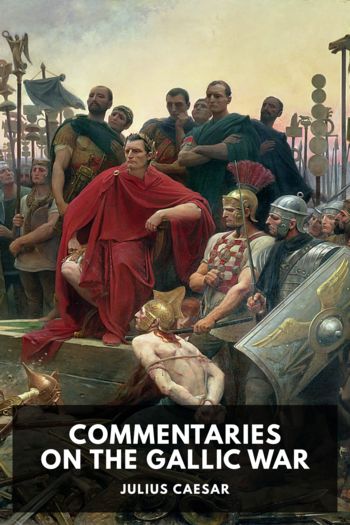Fateful Lightning: A New History of the Civil War & Reconstruction by Allen Guelzo (icecream ebook reader txt) 📗

- Author: Allen Guelzo
Book online «Fateful Lightning: A New History of the Civil War & Reconstruction by Allen Guelzo (icecream ebook reader txt) 📗». Author Allen Guelzo
The Whigs might have suffered the same splintering had it not been clear that the divisions among the Democratic Party were the Whigs’ golden opportunity. Rather than risk North-South bickerings within the party, the Whigs nominated Zachary Taylor for the presidency. Taylor’s victory at Buena Vista gave him instant name recognition; on the other hand, to the dismay of many anti-slavery Whigs, he was also a Louisiana slaveholder. Still, at least Taylor had taken no known stand on the territorial question. After reflecting upon the wisdom of nominating candidates with no inconvenient political views to disturb the voters, the Whig Party decided to do likewise, and adopted no party platform. By the end of the summer, it was plain that Taylor was going to beat Cass handily.22
To nearly everyone’s surprise, Zachary Taylor turned out to be no blank slate on the issue of the territories. “No man of ordinary capacity can believe,” Taylor wrote, that Congress would allow slavery into the Mexican Cession or “will ever permit a state made from it to enter our Union with the features of slavery connected with it.” By the time he was inaugurated in March 1849, the California gold rush was in full swing, and Sacramento, the site of the original gold strike, had exploded from a village of four houses into a boom city with a population of 10,000. In order to provide California and the New Mexico territory with some sense of public order, a bill for territorial organization had to be offered at once, and Taylor dispatched his own personal emissaries to prod the California, Utah, and New Mexico settlers into writing state constitutions that would bypass the need for (and the inevitable wrangling over) territorial organization.
Taylor was responding to more than just the practical demands of the California situation. A political novice, Taylor had fallen under the sway of some of the most radical anti-slavery Whigs, especially William Henry Seward of New York, and under their influence Taylor was determined that the California and New Mexico applications would be “free and Whig,” even at the risk of more Southern threats of disunion. By December 1849 Taylor had pushed the Californians to the point where they were ready to make an application to Congress for immediate statehood and thus “remove all causes of uneasiness… and confidence and kind feeling be preserved.” The application would be as a free state.23
Southerners read President Taylor’s proposal as nothing less than the Wilmot Proviso in disguise, and in June 1850 a convention of representatives from the slave-holding states met in Nashville to discuss what their future could be in the Union. At the same time, Taylor faced a challenge from within his own party in the person of Henry Clay, who still believed, even at age seventy-three and after three unsuccessful nominations, that he would have made a better Whig president than Taylor, the “Military Chieftain.”24
On January 29, 1850, Clay laid before the Senate a “comprehensive scheme” of eight resolutions that offered to settle the territorial dispute in practical little pieces rather than by sweeping formulas such as “common property” or “popular sovereignty.” Clay proposed to admit California as a free state (the California constitutional convention had already adopted free-state provisions and there was nothing gained by trying to force them to change their minds), but in order to show that this established no principle for the other territories, New Mexico and a separate Mexican Cession territory of Deseret (or Utah) would be allowed to organize themselves as territories on the basis of popular sovereignty (which left open the possibility that these territories might become slave states). To sweeten the loss of the “common property” principle for Southerners, Clay added a provision for a new Fugitive Slave Law, which would give slaveholders broader powers to stop the flow of runaway slaves northward to the free states, and he offered a final resolution denying that Congress had any authority to regulate the interstate slave trade.25
Clay’s two-day presentation of his compromise was a rhetorical masterpiece, but he fell considerably short of winning the votes he needed for it. The partisans of slavery in the Senate regarded the concession of California as tantamount to accepting the principle, if not the fact, of the Wilmot Proviso, while Northern Free-Soilers regarded the popular sovereignty allowance for New Mexico and Utah as little more than surrendering the territories outright to slavery. Clay also committed a major tactical error by insisting that all the resolutions be voted upon together as one “omnibus,” without recognizing that while all of the senators would like some of the resolutions, only some of the senators would like all of the resolutions, and the senators in that group were not numerous enough to carry the day.
In particular, Clay’s “comprehensive scheme” did not satisfy the mortally ailing John Calhoun. On March 4, 1850, Calhoun had another senator, James M. Mason of Virginia, read a lengthy and shrewd attack on Clay’s plan, calling again for “an equal right in the acquired territory… to cease the agitation of the slave question, and to provide for the insertion of a provision in the constitution, by an amendment, which will restore to the South, in substance, the power she possessed of protecting herself, before the equilibrium between the section was destroyed by the action of this government.” Otherwise, threatened Calhoun, “the Southern States… cannot remain, as things now are, consistently with safety and honor, in the Union.”26
Three days later, Daniel Webster of Massachusetts took the floor of





Comments (0)